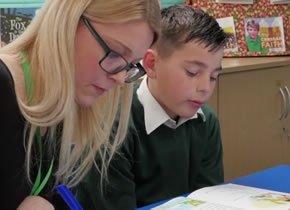
Request a full Catch Up® information brochure and details of our free information webinars
Find out more
Lots of struggling readers point at words along a line of print as they read them. Is this:
a. A good thing because it means they don’t lose their place?
or
b. A bad thing because it interrupts the fluency of their reading?
Beginner readers and struggling readers need to assist their eyes to follow a line of print, so they use a finger to help focus their visual attention. In the early stages of reading, a sentence is often a line length, so a pointing finger is matching a unit of meaning. However, as the texts become longer and a sentence runs over a line, then the child who is finger-pointing is often interrupting their comprehension as they have to move their finger to swing back to find the first word of the next line (which may be a continuation of a sentence started in the previous line).
Most pupils voluntarily abandon finger-pointing once their reading progress becomes more fluent. They have developed the muscles around the eyes which enable them to comfortably track lines of text. However, some children who have taken longer to become fluent, may be reluctant to abandon this support as they have become accustomed to the eyes following the finger rather than scanning the print.
My advice is, that from Catch Up® Literacy level 8 onwards, we should be encouraging children to ‘make their eyes do the work’ and not to point at each word as they read it. However, finger-pointing will have become such a habit for them it will take a bit of effort to persuade them to give it up!
Tips to help pupils make the transition from finger-pointing to eye-scanning
1. Try Paired Reading
Catch Up® is the working name of The Caxton Trust, a not-for-profit charity registered in England and Wales (1072425) and Scotland (SC047557) as well as a company limited by guarantee (03476510). Catch Up is a registered trademark.
The Catch Up® Web site use "cookies" to help you personalise your online experience. A cookie is a text file that is placed on your hard disk by a Web page server. Cookies cannot be used to run programs or deliver viruses to your computer. Cookies are uniquely assigned to you, and can only be read by a web server in the domain that issued the cookie to you.
Click on the different category headings below to find out more. You can change your default settings very easily. To turn cookies on, click the button to the right. To turn cookies off, click the buttons to the left. Please read our cookie policy to find out more.
Performance monitoring cookies: Google Analytics cookies (_ga,_gid) - these can last up to 2 years.
Strictly necessary cookies used by the site content management system: PHPSESSID (used to record your logged in session) and allow_cookies (used to record that the user has consented to cookies) - these are either temporary (session) cookies or expire after no more than 30 minutes and are used to provide functionality as you navigate around the site and allow you to access secure areas.